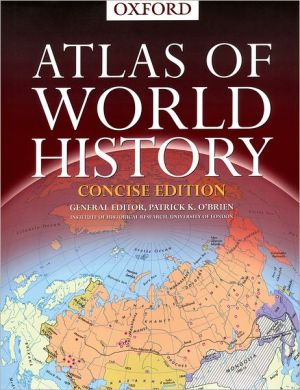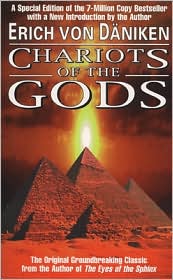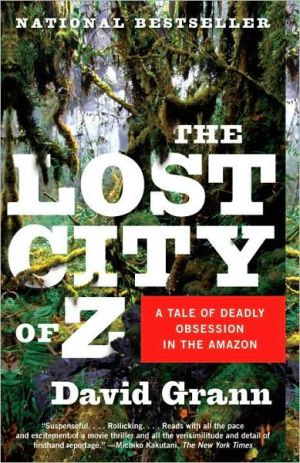Concise Atlas of World History
Synthesizing exceptional cartography and impeccable scholarship, the Atlas of World History traces 12,000 years of history with 450 full-color maps and over 200,000 words of text. Its outstanding features include:\ • More than 200 illustrations and tables\ • Longer essays on worldwide trends, political developments, and military conflicts, highlighting the most significant socioeconomic, cultural, and religious themes for five pivotal historical periods\ • Devotion to the rich past of Africa,...
Search in google:
Featuring 135 two-page spreads that highlight key moments in world history, this major new history atlas includes a skillful blend of maps, text, and illustrations to explain major events—from the origins of civilization to the dawn of the third millennium. Unique for its multicultural approach, the atlas draws on the latest research into Asian, African, and South American history and incorporates the expertise of specialist experts to examine specific eras—from the ancient world to the 20th century. Among the topics addressed are early civilizations, the Silk Road, and classical history; Islam, the Vikings, and the Incan and Aztec empires; the Age of Exploration, the Reformation, and the scientific revolution; the Age of Revolutions; and the Great Depression, the Second World War, and America after 1945. 9 3/4" x 13". Publishers Weekly This useful resource is also dangerously absorbing, allowing readers to pore over charts, maps and short articles on such subjects as the golden age of Athens, the 16th-century expansion of the Mughal Empire through India, the foreign policy of Mao Zedong and the break-up of the Soviet Union. This overview of human history, with 450 maps and 160 illustrations, begins with the emergence of Homo sapiens and culminates with the post-WWII era, moving among various regions of the globe in chronological order. It's divided into sections on ancient, medieval, early modern, Enlightenment and 20th century history, with easy-to-read two-page entries covering such subjects as "Barbarian Invasions of the Roman Empire, 100-500" and "The Development of Australia and New Zealand Since 1790." The section on postwar life includes charts showing migration patterns, female enfranchisement, distribution of wealth across the globe and changes in the environment. O'Brien, a professor at the London School of Economics, has done a fine job editing this concise edition, an excellent gift book for students of history. (Nov.) Copyright 2003 Cahners Business Information.
Foreword10The Ancient World12The Human Revolution: 5 Million Years Ago to 10,000 BC16From Hunting to Farming: Asia 12,000 BC-AD 50018From Hunting to Farming: Europe 8000-200 BC20From Hunting to Farming: Africa 10,000 BC-AD 50022From Hunting to Farming: The Americas 12,000-1000 BC24From Hunting to Farming: Australia and the Pacific 10,000 BC-AD 100026The First Civilizations: Mesopotamia and the Indus Region 4000-1800 BC28The First Civilizations: Egypt 3500-2180 BC and China 1700-1050 BC30Civilizations in Mesoamerica 1200 BC-AD 70032Cultures in South America 1400 BC-AD 100034The Mediterranean and the Gulf Region 2000-1000 BC36Empires and Traders 1200-600 BC38Classical Greece 750-400 BC40The Achaemenid and Hellenistic World 600-30 BC42The Birth of World Religions 1500 BC-AD 60044First Empires in India 600 BC-AD 50046First Empires in China 1100 BC-AD 22048Peoples of Central Asia 6000 BC-AD 50050Eurasian Trade 150 BC-AD 50052The Roman Empire 500 BC-AD 40054Barbarian Invasions of the Roman Empire 100-50056The Medieval World58Religions of the Medieval World 600-150062Kingdoms of Southeast Asia 500-150064The Byzantine Empire 527-102566The Spread of Islam 630-100068The First Slavic States 400-100070East Asia in the Tang Period 618-90772Frankish Kingdoms 200-90074Peoples of the European Steppe 350-100076The Vikings 800-110078States and Trade in West Africa 500-150080States and Trade in East Africa 500-150082Civilizations in Mesoamerica and South America 500-150084East Asia 907-160086The Muslim World 1000-140088The Holy Roman Empire 962-135690France, Spain and England 900-130092The World of the Crusaders 1095-129194The Decline of the Byzantine and Rise of the Ottoman Empires 1025-150096The Mongol Empire 1206-140598The Economy of Europe 950-1300100Urban Communities in Western Europe 1000-1500102Crisis in Europe and Asia 1330-52104Europe 1350-1500106Cultures in North America 500-1500108The Inca and Aztec Empires 1400-1540110The Early Modern World112The European Discovery of the World 1450-1600116Europeans in Asia 1500-1790118Spain and the Americas 1492-1550120The Colonization of Central and South America 1500-1780122The Colonization of North America and the Caribbean 1600-1763124Slave Economies of the Western Hemisphere 1500-1880126The Growth of the Atlantic Economies 1620-1775128The Rise of European Commercial Empires 1600-1800130European Urbanization 1500-1800132The Development of Science and Technology in Europe 1500-1770134Africa 1500-1800136Ming and Manchu Qing China 1368-1800138Tokugawa Japan 1603-1867140The Ottoman and Safavid Empires 1500-1683142India Under the Mughals 1526-1765144European States 1500-1600146The Expansion of Russia 1462-1795148Sweden, Poland and the Baltic 1500-1795150The Habsburg Empire 1490-1700152The Reformation and Counter Reformation in Europe 1517-1648154Revolution and Stability in Europe 1600-1785156The Development of Warfare in Europe 1450-1750158The Age of Revolutions160The American Revolution 1775-83164Revolutionary France and Napoleonic Europe 1789-1815166The Industrial Revolution in Britain 1750-1850168The Industrialization of Europe 1830-1914170Revolution and Reaction in Europe 1815-49172The Habsburg Empire: Expansion and Decline 1700-1918174The Unification of Italy and of Germany 1815-71176The Decline of the Ottoman Empire 1683-1923178Russian Territorial and Economic Expansion 1795-1914180The Westward Expansion of the United States 1783-1910182The American Civil War 1861-65184The Industrial Growth of the United States 1790-1900186The Development of Canada 1763-1914188Independence in Latin America and the Caribbean 1780-1830190Latin America and the Caribbean Post-Independence 1830-1914192The British in India 1608-1920194Southeast Asia in the Age of Imperialism 1790-1914196Late Manchu Qing China 1800-1911198The Modernization of Japan 1867-1937200The Development of Australia and New Zealand Since 1790202Africa 1800-80204The Partition of Africa 1880-1939206World Trade and Empires 1870-1914208World Population Growth and Urbanization 1800-1914210The Twentieth Century212The Build-Up to the First World War 1871-1914216The First World War 1914-18218Outcomes of the First World War 1918-29220The Russian Revolution 1917-39222The Republic of China 1911-49224Latin America 1914-45226The Great Depression 1929-33228The Rise of Fascism 1921-39230The Second World War in Europe 1939-45232The War in Asia 1931-45234The Soviet Union and Eastern Europe 1945-89236Western Europe Since 1945238The United States Since 1900240The Role of the United States in the World Since 1945242The Cold War 1947-91244The Breakdown of Empires Since 1945246South Asia Since 1920248Southeast Asia Since 1920250Japan Since 1945252The People's Republic of China Since 1949254Africa Since 1939256Latin America Since 1945258The Middle East Since 1945260The Former Republics of the Soviet Union Since 1989262Eastern Europe Since 1989264United Nations Peacekeeping Since 1945266Human Rights Since 1914268The Position of Women Since 1914270The World Economy Since 1945272Changes in Population Since 1945274Patterns of Health and Ill-Health Since 1945276Standards of Living Since 1945278The Changing Environment Since 1945280Transport and Communication Since 1945282Timecharts284Events, People and Places308Index340Bibliography364Acknowledgements368
\ Publishers WeeklyThis useful resource is also dangerously absorbing, allowing readers to pore over charts, maps and short articles on such subjects as the golden age of Athens, the 16th-century expansion of the Mughal Empire through India, the foreign policy of Mao Zedong and the break-up of the Soviet Union. This overview of human history, with 450 maps and 160 illustrations, begins with the emergence of Homo sapiens and culminates with the post-WWII era, moving among various regions of the globe in chronological order. It's divided into sections on ancient, medieval, early modern, Enlightenment and 20th century history, with easy-to-read two-page entries covering such subjects as "Barbarian Invasions of the Roman Empire, 100-500" and "The Development of Australia and New Zealand Since 1790." The section on postwar life includes charts showing migration patterns, female enfranchisement, distribution of wealth across the globe and changes in the environment. O'Brien, a professor at the London School of Economics, has done a fine job editing this concise edition, an excellent gift book for students of history. (Nov.) Copyright 2003 Cahners Business Information.\ \ \ \ \ Library JournalA synopsis of the world's political, social, and economic history, this title contains 450 color maps, as well as some other photographs and illustrations. Each of the five major chapters-"Ancient World," "Medieval World," "Early Modern World," "Age of Revolutions," and "Twentieth Century"-begins with a general introduction, followed by two-page segments summarizing different geographic regions and major trends or events. The book ends with an extensive index and a bibliography. The maps illustrate battles, conquests and exploration, trade, agriculture and industry, political boundaries, conflicts and colonies, urbanization and migration, and the spread of languages and religions. Given its tremendous scope, the text functions primarily as an overview, with the maps providing the real value. Therefore, it is puzzling that maps are not listed; a subject classification of maps would have greatly enhanced the book's usability. Despite the air of objectivity, certain omissions are noteworthy, e.g., in the segment on Latin America since 1945, the Cuban Revolution is relegated to an image caption, and mention of Colombia is curiously missing in the map on U.S. intervention in the region. Likewise, U.S. political intervention to further its economic objectives in the Middle East is altogether omitted, while the "War on Terrorism" and the events of 9/11 receive marked attention. Suitable for high schools, this may be too simplistic for students on the university level.-Anna Youssefi, Rice Univ. Lib., Houston, TX Copyright 2003 Cahners Business Information.\ \ \ School Library JournalGr 9 Up-This well-designed atlas is divided into five parts: "The Ancient World," "The Medieval World," "The Early Modern World," "The Age of Revolutions," and "The Twentieth Century." More than 450 color maps illustrate major themes and events of history; some photographs are included. Within the separate sections, an effort has also been made to look at religion, economic welfare, trade, technology, health, and human rights. The extensive index is cross-referenced, and the four-page bibliography is organized by topic, then continent. This concise edition is exactly the same as the original publication (Oxford, 1999), minus the time charts and the encyclopedic entries for 600 significant events, people, and places. The index was not modified to reflect all these omissions. To accommodate this edition's smaller size, the font has been significantly reduced, making it difficult to read. Stick with the original.-Peg Glisson, Mendon Center Elementary School, Pittsford, NY Copyright 2003 Reed Business Information.\ \ \ \ \ BooknewsThis reference presents the story of humanity as it evolved in its physical setting. From the first homo sapiens to the present, it presents the latest research into Asian, African, South and North American and European history. Each section deals with a particular era (the ancient, medieval, and early modern worlds; the age of revolutions; and the 20th century) and begins an introduction pointing out the main themes of the period, followed by coverage of the specific regions and events with maps, text, illustrations, and captions. Contains cross-references, and about 600 illustrations (color maps, photographs, and diagrams). Oversize: 9x11.5<">. Annotation c. Book News, Inc., Portland, OR (booknews.com)\ \








